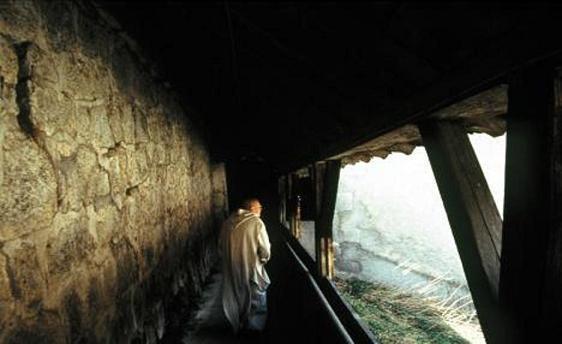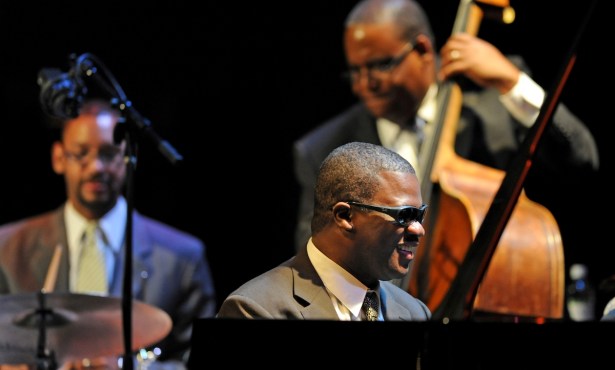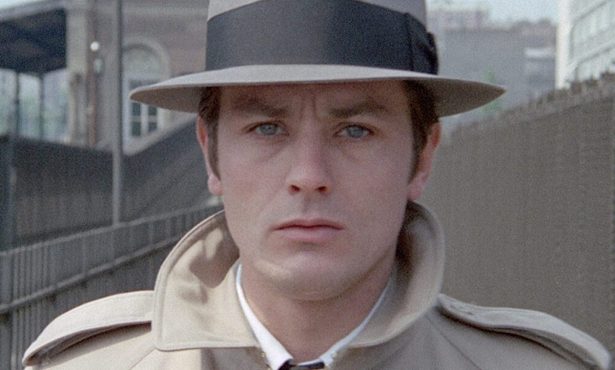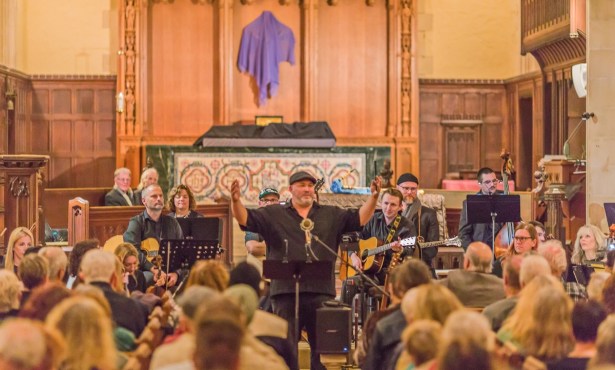The Ultimate Transport
An Essay on Into Great Silence
It begins as a shock. A hooded figure is
seated in the dark, so close to us he might be a piece of wood.
Flames flicker here and there against a field of black. We pull
back and see a figure in all white, head down, in a bare room.
There’s no patter, no background music, very little movement. The
camera breathes it all in in long, unswerving takes. You’ve entered
another world in this silent, snowbound cluster of small cells.
Each unworldly shot is a still life that says there’s still
life — vibrant, shifting, human life — in this other world; the
only thing that’s likely to move is you.

And very slowly, as the scenes go on — pealing bells, a monk
carefully snipping some fabric, another one reading a book — you
begin to see the textures in the wood, to notice the slanting of
the light, to make out sunlight and birdsong as you would never do
at home. The film starts to work on you — and in you, too — as its
subject might. You feel a clock ticking, a bee buzzing all around
you. The sound of monks gathering for prayer is thunderous. And
then one of them breaks into song and the sound is ineffably
sweet.
Into Great Silence (or The Great Stillness, as
its title was in German) is like no other movie you’ve ever seen,
though it has some of the slow attentiveness of a Terrence Malick
epic, something of Andrei Tarkovsky’s uncompromising intensity. It
is more a meditation than a film, really, a 162-minute observation
of life in La Grande Chartreuse, a charterhouse of the Carthusian
order of Catholic monks in the French Alps. There is no story, no
script, and certainly very little in the way of characterization.
Some viewers may run out screaming, as from a Noh drama, hungry for
movement and color of a more conventional kind. Others will find it
moves them as a prayer might; till a heart of stone, as the film
puts it, until it becomes a heart of flesh.
The documentary, directed by Philip Gröning (who waited 16 years
for a green light from the monks, and then was allowed to come in
alone and live with them for several months, shooting and recording
by himself with no artificial light), was called “exhilarating” by
Variety, and “entrancing” by the New York Times.
It won a Special Jury Prize at Sundance and was nominated for a
European Film Award. And now it enjoys its West Coast premiere at
UCSB’s Campbell Hall, next Monday, March 5 at 7:30 p.m.
The point of monasticism is to take you out of the world of time
(and change and loss) and back into the realm of changelessness.
The anonymous monks we follow through their seasons in the film,
therefore, do very little other than what their counterparts would
have done 900 years ago (or, in fact, what their Zen colleagues are
doing around me in Kyoto, where I write this). They chop wood and
kneel on bare floors to pray. They feed the local cats and pray
some more. They wheel a deafening trolley through the silence to
deliver lunch through a slot in every other monk’s cell. When, once
a week, they are allowed to take a walk (but not to eat or drink or
enter a secular house), you suddenly feel a wild release as the
monks clatter out into the sun and gossip and play in the snow and
talk about other monasteries like boys on holiday.
A monastery, and a monastic film like this, teaches you how to
see. It also leads you into a world of almost unimaginable
surrender. In one of the memorable scenes in the movie, we watch a
very elderly monk, almost audibly huffing and nearly falling in the
thick snow, working and working to shovel clear a small space in
the depths of winter. He all but kills himself in the process, you
feel, and yet all the effort is explained when, one season later,
the seeds he’s planted on the bare plot begin to shoot up.
It’s a metaphor, in short, and a monastery teaches you to see
everything metaphorically. The monks briskly cutting one another’s
hair are trimming one another’s vanity and claims to individuality.
Their white or black cloaks render them all but indistinguishable
from one another. Toward the end, one blind monk says he sees the
taking of his sight as a blessing; everything’s an adventure when
you’re in love. There are many other movies that could have made
about a community of hermits, and this one chooses not to explore
who these men are, what they’ve left behind them, or what comes to
them in the long, dark nights. It chooses not to dwell on doubt or
charity, and for the inner dramas beneath the surface stillness
you’ll have to turn to Thomas Merton. Yet instead of developing, it
deepens. And instead of giving us an external portrait of what a
monk’s life looks like, it takes us into that very life, so we see
and feel it from within. True to the monastic setting, all barriers
dissolve.
At intervals through the film, a sentence from scripture comes
up on screen (most often the single line, “You have seduced me, O
Lord, and I have let myself be seduced”), the same few sentences
recurring like the pealing bells. But this is not a film about
Catholicism so much as about the relationship any of us can have
with the invisible. At certain points, each of the monks just
stands before the camera, looking into it, and in each pair of eyes
you see a whole epic of light and shadow.
I have spent much of my adult life in a Benedictine monastery up
the coast, and in more than 16 years of staying as a visitor, and
sometimes living in the cloister, I’ve found there is no more
exciting and transporting journey the modern world has to offer.
The stony, silent cloister discovered in this film during midwinter
could not, of course, be more different on the surface from the
expansive radiance of Big Sur. But the beauty of a film like this
is that it takes you beyond names and places and dates to something
we can all recognize when we just sit still.
The point of a motion picture is to take you somewhere, and show
you the world you thought you knew in a radically different light.
Into Great Silence may bore or confound some, but for
those with a taste for silence, it can take you into a far-off
world that is as close as your own heartbeat. Before you know it,
you’re somewhere — someone — else.
4•1•1
Into Great Silence makes its West Coast premiere at
UCSB’s Campbell Hall on Monday, March 5 at 7:30 p.m. Call 893-3535
or visit www.artsandlectures.ucsb.edu
for more information.



